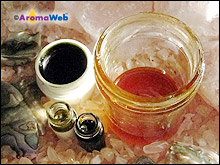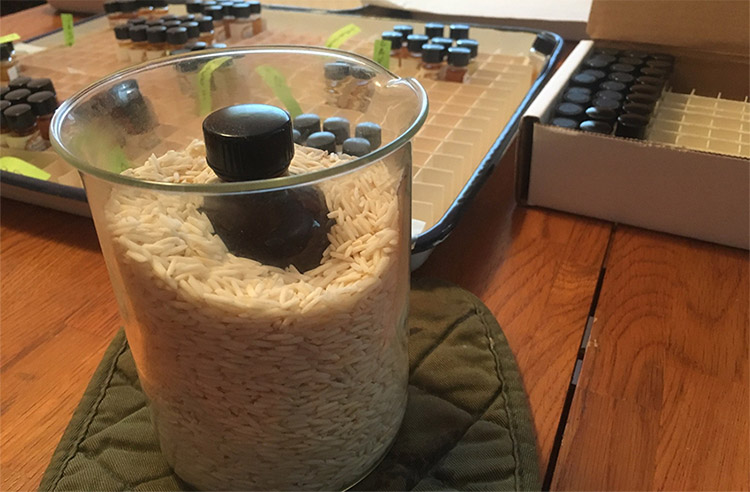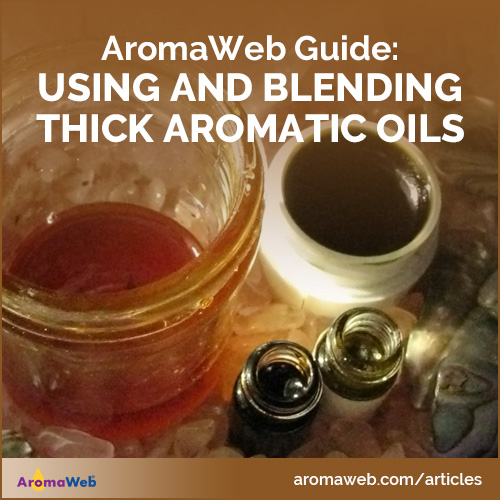Using and Blending Thick Aromatic Oils

Pictured clockwise from top left are Calendula CO2, Benzoin Resin, Peru Balsam and Rose Absolute.
Most essential oils are thin in viscosity, meaning they are almost of a water-like consistency. Some steam distilled essential oils, namely patchouli and sandalwood, are thicker but still are relatively easy to work with. Some CO2s, absolutes, balsams, resins and other botanical aromatics, however, can be nearly solid at room temperature and are much harder to work with, measure and blend.
The traditional method for working with thick essential oils is to gently heat them. Heating oils until they are at a workable consistency helps, but it's important to heat oils gently and for as brief a period as possible. Heat can potentially destroy the fragile constituents of particular oils.
Tip #1: Warm Rice Method

Photo Courtesy of Anya McCoy and the Natural Perfumery Institute. Photo Used With Permission. All Rights Reserved.
I'm honored that Anya McCoy, the founder and head instructor for the Natural Perfumery Institute, shared the following incredibly helpful technique that uses rice as the warming agent. It is superior to directly heating essential oil bottles in a water bath (I'll still include that method below as tip #2).
- Microwave approximately 1 cup of dry rice in a microwave safe beaker or container for one minute, or until it is uniformly quite warm. The amount of rice and size of the container can be increased to accommodate the size of the bottle of aromatics. Do not microwave the aromatic oil.
- Stir the rice to distribute the heat evenly.
- Put the aromatic bottle into the hot rice and leave it there until the rice heats the aromatic and renders it more pourable.
- The aromatic is now more fluid in its original bottle. However, once you put a dropper into it, or pour it into another container that isn't warmed up, it will quickly get thicker again. Because of this, it might be best to pour the aromatic into the dilution bottle instead of using a dropper. Try to pour as quickly and neatly as possible. Once the heated aromatic touches the rim of the new bottle, it can build up there quickly and close off the neck or opening of the bottle.
The heated rice is reusable. Being dry, it doesn't degrade the bottle labels as much as with heating an aromatic in a hot water bath, or bain marie.
Source: This tip is provided by and used with express permission from Anya McCoy, Founder and Head Instructor for the Natural Perfumery Institute. It was originally published in the textbook for the institute's Natural Perfumery Course. Special thanks to Michael Singels for his creativity in discovering this technique.
Tip #2: Warm Water Bath Method
Gently heat the bottle or jar of oil by placing it in a small bowl of warm water, and then allow the bottle to rest in the warm water for 10 minutes or more. If the water cools, replace the water. It is often a trial-and-error process, and each oil can differ in the precise temperature of warm water that works and the length of time that's needed for the oil to reach a workable consistency. This method can also be used for liquefying balsams and resins like benzoin. I have also used it to loosen hard vegetable butters from their containers for easier removal.
One of the disadvantages of this technique are that you risk damaging the legibility of labels. If that matters to you, you can try applying a waterproof, clear tape to the label before submerging the container into water.
Marge Clark is founder and President of Nature's Gift and is one of AromaWeb's largest advertisers and supporters. Marge is an expert in working with precious, rare and thick absolutes, CO2s and other aromatic oils. I asked her for her input in compiling tips in working with solid/thick oils, and she happily shared some especially helpful tidbits:
- Heat thick oils in warm water. Mentally imagine how baby bottles are gently warmed. If you are planning to blend the oil with a carrier oil, be sure to also warm the carrier oil. "Plunking a warm dollop of, let's say Calendula Total into cold jojoba gives you jojoba with a blob of CO2 in it."
- Marge discovered that using a triple boiler heating method rather than just using a double boiler helps, especially when heating a tiny bottle. Marge recommends placing the small bottle in a custard cup or tea cup with a small bit of warm water. Then set the small cup into a larger container of hot water.
Related Tips
- Even when warmed, it's usually not possible or accurate to measure thick oils by the drop. Marge and I both measure thick oils by weight using a scale that weighs by the gram. Digital postal scales are one option if you happen to have one that measures in grams, but I tend not to use that type of scale for measuring tiny quantities. I prefer more accuracy, and use a pocket digital scale that can measure in fractions of a gram (I believe more formally referred to as centigrams and decigrams). Amazon.com sells digital pocket scales, including the American Weigh Precision Digital Pocket Scale that has good reviews and is priced at $18.99 (at the time of this writing). This comment is intended for informational purposes only and is not a recommendation or endorsement for that scale. You can search Amazon for other scales by using the search term gram scales. Whatever scale you choose, be sure it has a tare function that lets you add an empty container and then set the scale to zero to then only weight what you put into the container. Disclamer: AromaWeb receives a small commission if you click on the Amazon links and make a purchase (thanks!).
- Marge mentions that when diluting thicker oils in large amounts, it is sometimes better to add a tiny bit of the warmed carrier to the warmed (but still semi-solid) oil, stir until blended, add another dollop and repeat. She adds that her process is not much unlike making a sauce in her kitchen. ;)
- Almost every absolute will dilute better in alcohol than in a carrier oil, and particular oils including some beeswax and cocoa absolutes will never dilute in carrier oils.
- It happens to all of us that use thicker CO2s and absolutes: We have dropped, dripped and/or scooped out as much of the oil as we can, but we know there's still a tad more left in the bottle. Using Marge's techniques above, you can add alcohol or carrier oil (depending on the method of extraction) to the nearly empty bottle. and then enjoy using those last few drops by way of the dilution that you just created.
A special thank you to Marge Clark, President of Nature's Gift for sharing her expertise and these invaluable tips.
If you are in doubt or are having trouble working with a particular oil, contact the company that you purchased the oil from. They are most familiar with the particular oil that you purchased and should be quite experienced at working with it.
Aromatherapy Blending Guide:
- Part 1: Introduction to Blending Essential Oils
- Part 2: Aromatic Blending of Essential Oils
- Part 3: Formulating Masculine/Earthy Aromatherapy Blends
- Part 4: Therapeutic Blending of Essential Oils
- Part 5: Working With and Blending Thick Aromatic Oils (You Are On This Page Now)
- Part 6: How to Substitute Essential Oils in Aromatherapy Recipes and Blends
- Part 7: Safely Diluted Essential Oil Blends May Seem Weak At First
See Also:
